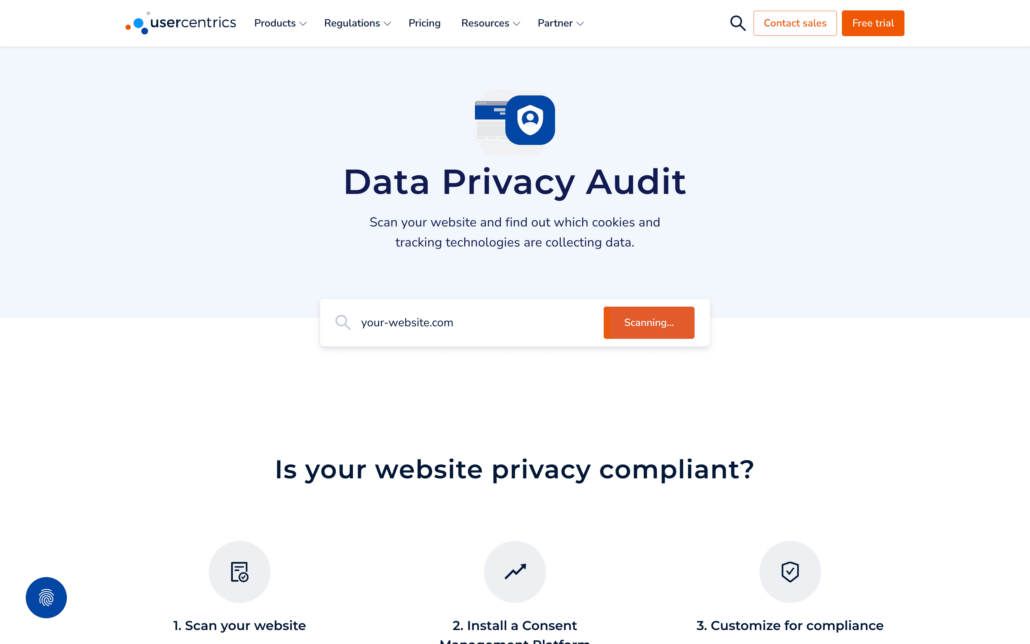The General Data Protection Regulation (GDPR) has been highly influential with subsequent data privacy legislation in countries around the world. The GDPR is extraterritorial, so it has far-reaching implications for businesses worldwide that process the personal data of European residents, not just businesses based in Europe.
For startups eager to rapidly scale while maintaining customer trust and avoiding regulatory issues, it’s crucial to achieve GDPR compliance right from the outset. But it’s important to note that this isn’t just about avoiding hefty fines. It’s about weaving a culture of privacy into the very fabric of your business.
Embracing GDPR principles means more than meeting regulatory requirements; it involves a strategic transformation where privacy becomes a key aspect of your product design and customer interactions. This shift helps to mitigate risks and enhances customer confidence and loyalty, giving your startup a competitive edge in today’s privacy-sensitive world.
Integrating GDPR compliance into your business strategy helps to protect consumer data and positions you as a forward-thinking, trustworthy entity ready for the challenges of global markets.
Why startups should care about the GDPR
Complying with the GDPR shows that your startup is committed to upholding data protection standards. Implementing data privacy right from the beginning doesn’t have to be difficult.
While large corporations can struggle with the amount of work needed to build their privacy operations, startups can build privacy-led operations from the ground up, enabling you to be ready for future regulatory and technology changes.
Neglecting data privacy during early stages can result in serious repercussions once your company starts to grow, especially if you’re considering international expansion after building a strong domestic base. Businesses that transfer data internationally need to meet additional standards under data privacy laws and guidelines.
As regulatory coverage and guidelines from national data protection authorities become more prevalent around the world, “privacy by design” and “privacy by default,” become smarter and smarter strategies for startups.
Most websites and apps collect data via use of cookies and other tracking technologies, so data privacy isn’t just important to a few companies working in sensitive industries, like finance or healthcare. That said, companies requiring access to and processing of sensitive personal data do need to adhere to even stricter standards for data use and protection.
Implementing a strong data privacy strategy from the start will provide your company with several strategic advantages:
- Build customer trust: Complying with privacy regulations is key to establishing trust in your company and brand. Customers increasingly expect careful and transparent handling of their data. Failing to meet these expectations can lead to a loss of reputation, customers, and revenue for your business.
- Saves time down the line: Looking at why and how you collect data now can influence the way you develop your product. Designing with privacy and data protection in mind from the beginning will save time and money later down the line, as well as technical demands as technologies and products evolve.
- Positions you better for investing: When working with investors, ignoring data privacy can be an obstacle and lead to delays or loss of deals. Many VCs expect to see a privacy strategy from the get-go.
- Helps you grow revenue: In the apps market, advertisers are increasingly reserving premium ad inventory for companies and apps or games that can demonstrate that they obtain valid user consent. Data privacy compliance can make a big difference to your bottom line.
Read about GDPR compliance software now
11-point GDPR compliance checklist for startups
Here are the essential areas your startup should focus on to achieve and maintain GDPR compliance.
1. Conduct data mapping
What data are you collecting, what legal basis are you using, where is it coming from, what is it being used for, and what parties all have access to it?
Understanding your data sources is key to achieving GDPR compliance and creating a solid privacy strategy. You’ll see that the following steps on this checklist rely heavily on identifying the cookies your website collects, especially as some active cookies can be hard to detect from third-party vendors. Therefore, conducting a website audit to map your data access and use is an important starting point.

2. Appoint a Data Protection Officer
Appointing a Data Protection Officer (DPO) early on is advisable, as it sets you in the right direction and builds structure at an early stage.
If you know that your company processes sensitive data or if its core activities require large scale, regular, and systematic monitoring, hiring a DPO is a safe and proactive approach to supporting privacy compliance and growth. For some companies’ operations, it’s also legally required.
If you’re still unsure whether to hire a DPO, the UK Information Commissioner’s Office (ICO) has compiled a short checklist to help you with this decision.
3. Limit data collection
Data minimization is a fundamental GDPR principle, guiding businesses to limit the volume and scope of personal data they collect.
For example, less is definitely more when it comes to forms that solicit personal information. Only ask for details that are absolutely necessary to complete the process or provide the product or service you’re requesting data for.
People feel more comfortable and are more likely to interact when they see their privacy is valued and protected. Also make sure you provide clear information not only about what data you collect, but why.
It is also important to create marketing strategies that rely less on sensitive user data or third-party data. This also aligns with the general move away from third-party data, and toward zero- and first-party data. For example, while reviewing your mailing list opt-in form, consider if you really need more personal information than a first name and email address?
Make it a routine to review and refine your data collection methods, ensuring every piece of information you gather has a clear purpose and adds value, keeping your business lean and compliant. Also consider investing in preference management, to get high quality data directly from your customers, and to build your relationship with them by putting them in control of communications and services from your company.
Once you have identified which data you collect and for what reasons, periodically review and delete any unnecessary data. Also keep abreast of relevant privacy laws and guidelines that may have requirements for data retention and/or deletion.
4. Identify legal basis
You can only process data under the GDPR with a legal basis, and you must be able to prove the relevance of the chosen legal basis to data protection authorities. Under the GDPR, the relevant legal bases are:
- consent
- legal obligation
- contractual obligation
- legitimate interest
- vital interest
- public task
Identify what basis applies to the data that your company collects, and be sure to include this information, in detail, in your privacy statement.
If yours is a business providing products or services and collecting personal data from consumers, there’s a good chance that consent is the right option for your company. But you also need to ensure that you adhere to the requirements for valid consent from users under the GDPR.
5. Fine-tune your privacy policy
The privacy policy is the backbone of any privacy strategy, creating the basis of trust and transparency between you and the people who interact with your business online. It’s also critical that it be kept up to date.
More and more consumers are paying attention to the details of privacy policies, so don’t make the mistake of thinking that your customers will only scroll past it. Plus, according to Art. 12 GDPR, you must ensure that your policies are easy to understand.
That’s why companies such as Usercentrics’ partner Termageddon offer policy generation services to create straightforward GDPR privacy policies tailored to specific business needs.
6. Implement a compliant Consent Management Platform
Implementing a GDPR-compliant Consent Management Platform (CMP), like Usercentrics CMP, early on in the execution of your privacy strategy will give your startup a competitive advantage by enabling you to provide clear data use and consent choices to users.
A high performance CMP takes care of securely collecting, storing, and managing explicit user consents according to major global regulations. It also keeps up to date with changes to existing regulations and the implementation of new laws through regular product updates, so you don’t have to figure out the complexities on your own.
Read about GDPR implementation now
The Usercentrics CMP is distinguished by:
- Compatibility: It integrates seamlessly with many major marketing tools and your tech stack, enabling compliant consent management across platforms.
- Customization: Its fully customizable interface enables alignment with your brand’s colors, messaging, specific web technologies, and applicable legal frameworks.
- Enhanced user experience features: Gaining user interaction insights from the in-depth analytics, then employing A/B testing enables you to quickly and frequently optimize consent banners to boost opt-in rates and evolve your data privacy strategy.
- Detailed interaction insights and actionable reporting: Better understand how and why users interact with your CMP via metrics like interaction, and acceptance rates. (For more information, check out our whitepaper: Optimizing Consent Data and User Trust.)
- Full support: Get extensive documentation to guide your setup and maintenance, as well as access to our ticketing system and your dedicated Customer Success Manager (with specific plans).
7. Adopt a privacy by design approach
While having a cookie banner that only allows for opt-in may seem like the surest way to get consent, it isn’t. And it violates GDPR requirements.
Adopting a privacy by design approach means embedding privacy into the very architecture of your systems and business practices, and providing a proactive framework for more complete privacy protection. Some best practices to follow that’ll help with this include:
- Minimizing data collection: Collect only the data that is absolutely necessary for the functioning of your service. Before collecting any data, ask yourself if the function of your product or service can be achieved without it.
- Encrypting data: Ensure that any data you collect is encrypted both in transit and at rest. This secures the data from unauthorized access and adds another layer of protection against data breaches. Use strong encryption methods and keep your encryption keys secure.
- Anonymizing data: Whenever possible, anonymize the data you store. This means stripping the data of personally identifiable information (PII) so that it can’t be traced back to an individual. This helps in reducing compliance burdens, especially when processing data for analytics and business intelligence.
- Embedding privacy settings: Make privacy settings a part of your product’s default configuration. Give people access to modify these settings according to their preferences without navigating through complex menus. Transparent privacy settings empower users and build trust.
- Conducting regular privacy impact assessments (PIAs): Conduct regular PIAs to identify and mitigate risks associated with data processing activities. This proactive approach not only ensures compliance with the GDPR but also helps refine privacy protocols over time.
- Training staff: Ensure that all employees understand the importance of privacy and are trained on GDPR compliance aspects relevant to their roles. Regular training sessions and updates about data protection policies can help foster a culture of privacy within the organization.
- Design user interfaces that encourage privacy: When designing user interfaces, ensure that privacy information is easily accessible and understandable. For example, when people are presented with a consent request, provide a clear, concise explanation of what your business will use the data for.
8. Collect granular consent
Granular consent under the GDPR means breaking down permission requests into individual elements, enabling individuals to explicitly choose what they agree to share.
Not all types of consent are equal. That’s why we created a list of criteria for GDPR-compliant consent to explain the degree of granularity that must be provided.
Users need to be able to opt out as easily as they can opt in and change or revoke their consent in the future.
Here are some of the core principles of granular consent:
- Specificity: A user should know precisely why their data is being collected and what it will be used for.
- Voluntariness: Users must give consent freely, without any pressure or manipulation.
- Informed: Individuals must be fully informed about the data controller’s identity, the types of data being collected, and the details of the processing and storage.
- Unambiguous: There must be a clear affirmative action by the user to signify consent. Pre-selected consent boxes or assuming consent from passive actions like scrolling are not acceptable.
- Active choice: Users should be given clear yes/no options (ideally with granular choices as well).
- Documented: Consent must be documented, showing what the user has consented to, including the information they were presented with at the time of consent and changing in consent information over time.
- Easy to withdraw: Users should be able to change their preferences or completely opt out of data processing at any time and with ease. If they do so, data collection and processing must stop right away.
9. Store data in the EU
All data collected should be stored in the EU. For startups looking to comply, here’s how you can efficiently manage and store your data:
- Choose the right cloud provider: Be familiar with requirements for international data transfers. Where possible, opt for cloud services with EU data centers. Major cloud providers offer options to specifically choose data storage locations within the EU. Ensure these providers comply with the GDPR and offer strong security measures.
- Segregate your data: Under the GDPR, collecting, processing, and storing sensitive data comes with additional compliance requirements. Keep sensitive data separate from other information. This practice enables you to enhance security for this category of data and helps you to simplify your data protection processes.
- Maintain detailed documentation: Keep accurate records of where your data is stored, the type of data, who can access it, and how long it is retained. Implement logging systems that track data access and modifications to maintain a comprehensive audit trail.
- Conduct regular audits: Periodically review your data storage and management practices to ensure they meet GDPR standards. Audit your external providers and internal controls, preferably on a yearly basis, to maintain compliance and address any vulnerabilities promptly.
- Implement data minimization: Adhere to GDPR principles and requirements of national data protection authorities by only storing necessary data for the required period. Establish clear data retention policies that dictate how long different types of data are kept and ensure data is deleted when it’s no longer needed.
10. Create a Data Processing Agreement
If your startup hires third-party companies to handle tasks that involve personal data — think storing information in the cloud, managing payroll, or customer support — it’s crucial to make sure these companies abide by GDPR regulatory requirements. That’s where a Data Processing Agreement (DPA) comes into play.
A DPA is a contract and set of instructions and expectations between your startup and any third-party service that deals with data and its processing. This agreement helps ensure that everyone is clear on how the data needs to be handled.
Having a DPA ensures that the companies you partner with take data protection as seriously as you do. Under the GDPR, the controller (your company) is responsible for data privacy compliance — or violations — by processors working for you.
11. Implement company-wide measures
A company’s GDPR strategy shouldn’t be left solely to the legal department or DPO, but should be seen through a holistic lens.
Privacy is the new normal, and by creating awareness and understanding with all staff, every product idea or marketing strategy will be created with privacy in mind.
Fortunately, data protection is becoming increasingly relevant as companies focus on what’s best for customers, and a long-term view of building engagement and relationships. This is why starting early is the smartest policy.
Privacy from the start should be your goal as a company
Creating the right data privacy strategy isn’t always a walk in the park, but there are many resources to help you in the right direction. Check out our extensive Knowledge Hub or sign up for our many panel discussions where you can learn more about all things data privacy.
To learn more about the Usercentrics CMP and how it can help your startup seamlessly achieve and maintain GDPR compliance, contact our experts for a free consultation.



